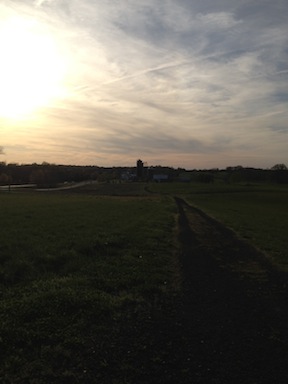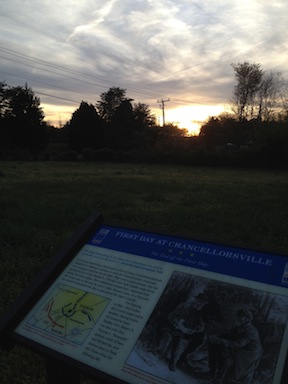In Praise of Preservationists

Most of the time, we think of preservationist “out in the trenches,” doing the front-line work to save dirt and grass and history. On Tuesday, at least, when I had the good pleasure of spending some time with folks from the Central Virginia Battlefield Trust (CVBT) and the Civil War Trust (CWT), they were tucked in their cubicles and rooting through file cabinets. Such was the glorious (and probably thankless) work of Civil War preservation.
I started the morning with Jerry Brent, executive director of CVBT. I’m working on a project that outlines the history of land acquisition for the Chancellorsville battlefield, and CVBT has played an important role. Jerry helped me sort through files of old correspondence, reminiscing a little as we went.
“I’m from around here, so I can sit on someone’s front porch and talk about the old times with them,” he said, explaining one of his keys to success. His local roots help Jerry connect.
“We work really well with the Trust,” Jerry explains. “A lot of people think we might be in competition, but we’re not. We all want the same thing.” The two groups complement each other well. An organization like CVBT acts like a set of local eyes on the ground—something CWT can’t necessarily do because they cover such a large scale. Local preservation groups, therefore, make crucial partners because they have the pulse of the local real estate market.
“We might also pick up parcels that would be too small for CWT to be interested in,” Brent says. For example, CVBT has picked up portions of the old Talley Farm, along the south side of Route 3.
The CWT, of course, has a nationwide scope. Current campaigns include Cedar Creek and Cross Keys, both in Virginia’s Shenandoah Valley, but also Fallen Timbers at the heart of the Shiloh Battlefield in Tennessee and Mill Springs and Perryville, both in Kentucky. It’s not uncommon for CWT to have a dozen balls in the air at once.
 Mark Coombs, one of CWT’s policy directors, spent some time walking me through the organization’s news files. I was looking for old newspaper clippings. Of particular interest was the so-called “Second Battle of Chancellorsville,” fought in the early part of the aughts, when a landowner wanted to plop an “instant city” on ground where the Battle of Chancellorsville opened. CWT led a nationwide campaign to raise awareness about the threat to the battlefield. They partnered with CVBT and five other preservation groups to battle the development—and in dramatic fashion, the preservationists prevailed.
Mark Coombs, one of CWT’s policy directors, spent some time walking me through the organization’s news files. I was looking for old newspaper clippings. Of particular interest was the so-called “Second Battle of Chancellorsville,” fought in the early part of the aughts, when a landowner wanted to plop an “instant city” on ground where the Battle of Chancellorsville opened. CWT led a nationwide campaign to raise awareness about the threat to the battlefield. They partnered with CVBT and five other preservation groups to battle the development—and in dramatic fashion, the preservationists prevailed.
Ultimately, a new developer came in and got some zoning concessions from Spotsylvania County in exchange for a big chunk of preserved battlefield and some viewshed adjustments. It was win-win-win for the developer, the county, and preservationists—and the battlefield itself.
During my visit, everyone at CWT was so cordial, so helpful. The suite of offices was sparse but well-kept (exactly what I would expect from an organization that spends most of its budget on land preservation and not on executive suites). Lots of Civil War art and landscape photography adorned the walls. There was a great earnest energy that thrummed throughout that place.
As Mark sat at his desk, I couldn’t help but wonder just how far away the battlefields—any battlefields—must seem when the only thing he can see out his office window are straight ribbons of blacktop that run along the bottoms of office-building canyons. Cars criss-cross the intersections and pedestrians scurry like ants. I suspect there are days the fine folks on the ninth floor long for the wide-open space of the battlefields.
Instead, they’re plugging away at their computers, tucked in their offices, doing the unglorious work of saving our history. I was glad to be reminded of their hard effort, so far from the fields they’re saving.
 I ended the day by walking the four-mile trail across Chancellorsville’s Day One battlefield, preserved through the cooperative efforts of CVBT and CWT. I make it to the final sign, featuring an image of the Lee-Jackson Cracker Box meeting, just as the sun was settling into the treeline. “As the sun dipped below the horizon in front of them,” the sign read. Perfect timing, I thought.
I ended the day by walking the four-mile trail across Chancellorsville’s Day One battlefield, preserved through the cooperative efforts of CVBT and CWT. I make it to the final sign, featuring an image of the Lee-Jackson Cracker Box meeting, just as the sun was settling into the treeline. “As the sun dipped below the horizon in front of them,” the sign read. Perfect timing, I thought.
How glad I was to finish out the day enjoying the hallowed ground saved, in part, by the work of the men I’d spent the day with. How thankful I was for their work in making sure this land was here for all of us.
This does bring back memories. As part of the Chancellorsville Collation I can remember when John Cummings produced a hand drawn map showing the 1863 period tree line. Although it was early in the process, it was presented as a compromise position to define the open land along Rt. 3 as the vital area to be preserved. At the time the map was discussed by Collation and set aside, then it was lent to Johnny Mitchell. It must have gotten to the right people, because the Spotsylvania board of Supervisors, CWT and the developers finally came to an agreement very close to the original proposal. It turned out to be the best win-win deal I have seen in this county.